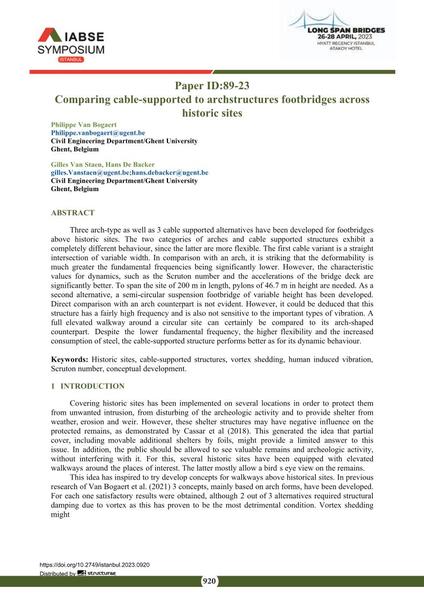Comparing cable-supported to archstructures footbridges across historic sites

|
|
|||||||||||
Bibliographic Details
| Author(s): |
Philippe Van Bogaert
(Civil Engineering Department/Ghent University Ghent, Belgium)
Gilles Van Staen (Civil Engineering Department/Ghent University Ghent, Belgium ) Hans De Backer (Civil Engineering Department/Ghent University Ghent, Belgium ) |
||||
|---|---|---|---|---|---|
| Medium: | conference paper | ||||
| Language(s): | English | ||||
| Conference: | IABSE Symposium: Long Span Bridges, Istanbul, Turkey, 26-28 April 2023 | ||||
| Published in: | IABSE Symposium Istanbul 2023 | ||||
|
|||||
| Page(s): | 920-927 | ||||
| Total no. of pages: | 8 | ||||
| Year: | 2023 | ||||
| DOI: | 10.2749/istanbul.2023.0920 | ||||
| Abstract: |
Three arch-type as well as 3 cable supported alternatives have been developed for footbridges above historic sites. The two categories of arches and cable supported structures exhibit a completely different behaviour, since the latter are more flexible. The first cable variant is a straight intersection of variable width. In comparison with an arch, it is striking that the deformability is much greater the fundamental frequencies being significantly lower. However, the characteristic values for dynamics, such as the Scruton number and the accelerations of the bridge deck are significantly better. To span the site of 200 m in length, pylons of 46.7 m in height are needed. As a second alternative, a semi-circular suspension footbridge of variable height has been developed. Direct comparison with an arch counterpart is not evident. However, it could be deduced that this structure has a fairly high frequency and is also not sensitive to the important types of vibration. A full elevated walkway around a circular site can certainly be compared to its arch-shaped counterpart. Despite the lower fundamental frequency, the higher flexibility and the increased consumption of steel, the cable-supported structure performs better as for its dynamic behaviour. |
||||
| Keywords: |
vortex shedding human induced vibration cable-supported structures Historic sites Scruton number conceptual development
|
||||



